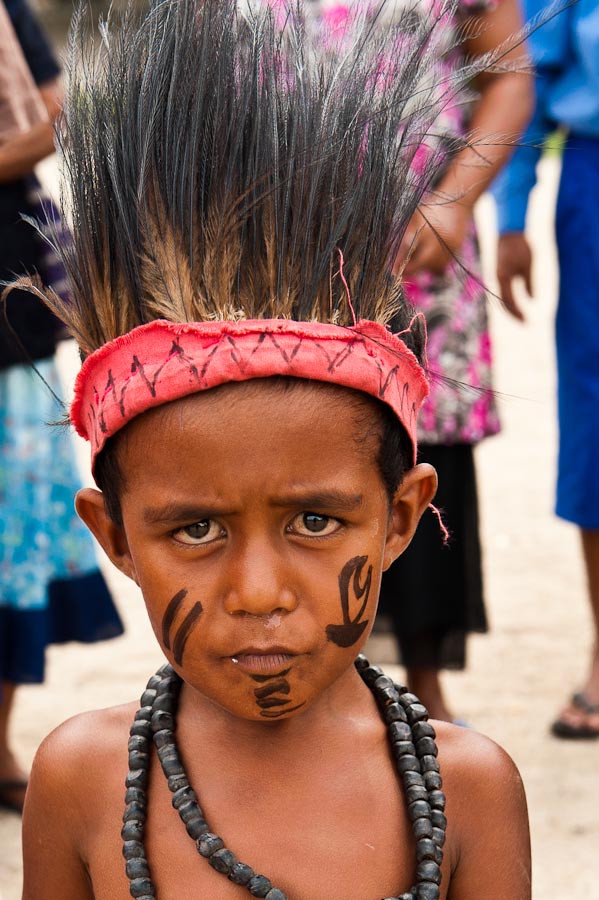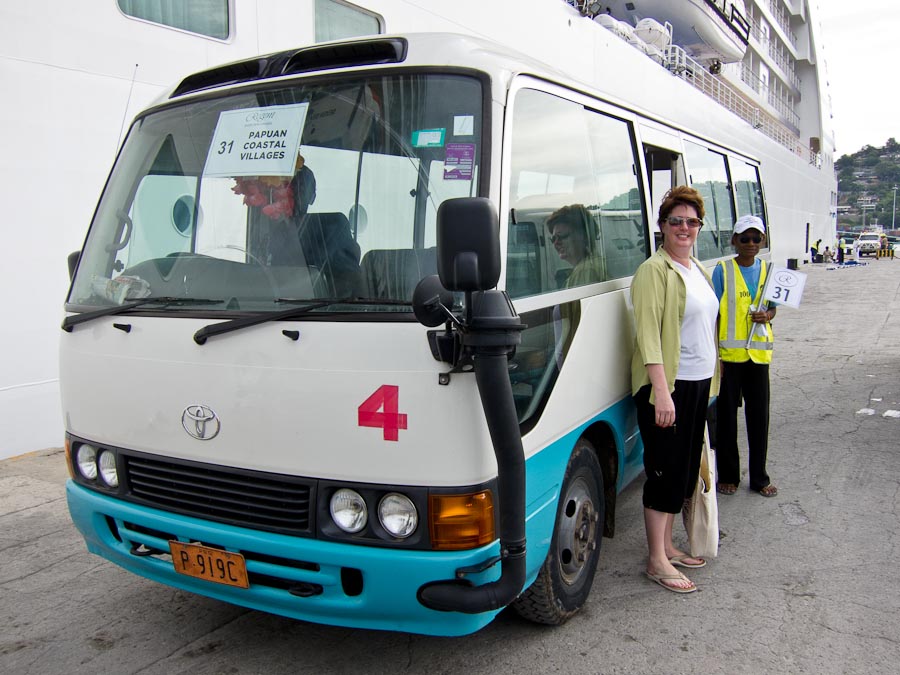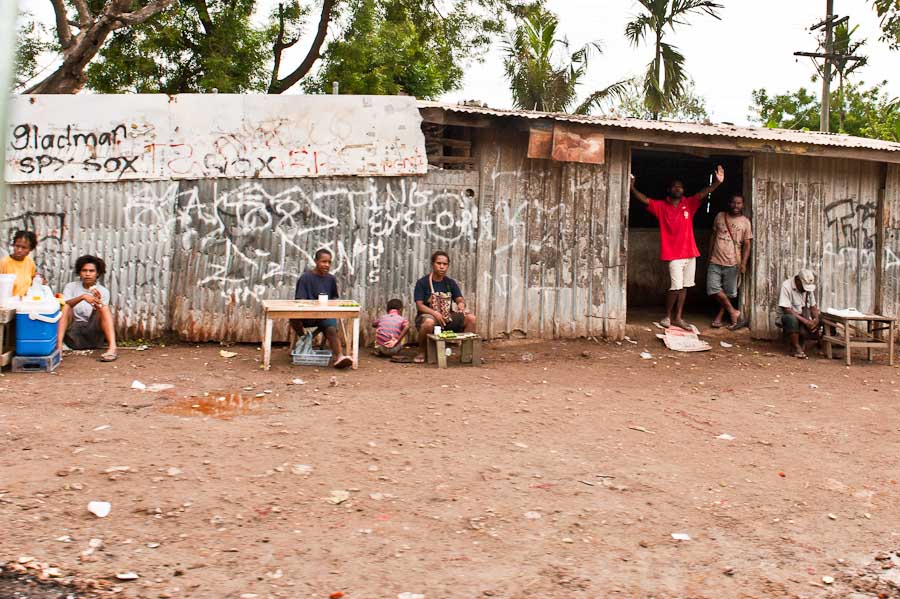We are in cannibalism territory again in Melanesia having arrived at Port Moresby in Papua New Guinea, which is widely abbreviated PNG widely around town. It is hot and humid, but we didn’t get rained on here. Papua New Guinea is one of the most culturally diverse countries on Earth, with over 850 indigenous languages and at least as many traditional societies/tribes, out of a population of just under seven million. It is also one of the most rural, with only 18% of its people live in urban centers. The name Papua translates loosely into “curly headed black people” and it was named “New Guinea” after Guinea in Africa.
Click here for the link to the Photo Gallery for Papua New Guinea.
The tour buses were delayed in their arrival, and when they showed up we realized why. They were using the local transport buses that held only 16 people each. That meant a lot of buses and a lot of confusion in arranging them in order to come to the dock and collect the nice Regent folks. Since we used over 30 buses, it also meant that the locals were having to crowd into the remaining buses as they tried to get around town!
Once on board, we started to come to the understanding that this wasn’t a “clean” area. I tried to pull my seat belt out, it was stuck on the side of the cushion, and when I couldn’t free it I looked at my fingers and they were black with dirt and grime. Yuck. Luckily I had some antibacterial wet wipes with me and I ended up using two of them!
As we drove out to our “Coastal Villages” tour, I was shocked to see the poverty. There were a lot of people hanging around, most of them waved at us with a look on their face like they just saw dinner! The other shocking thing here is the amount of garbage strewn everywhere. The people basically live “in garbage”. The roads, streams, yards, beaches are all covered in garbage.
Once out of the city, we continued to be a little nervous as we drove through some beautiful, but desolate countryside. We had a local driver and guide and neither of them seemed to speak or understand English…we were hoping they knew where they were going.
About 45 minutes later we pulled up to a local village and were instructed to stand in a dirt field as local children started to filter out from the surrounding school buildings. We waited about 15 minutes for some other buses to arrive and then were treated to a culture show put on by a few adults and some of the children.
After the show they told us to walk around the village…OK, not sure where to go, Dale was still taking pictures of the costumed children so I ended up following some other folks down to the water. The locals build their “homes” over the water, for good reason…their “plumbing” dumps directly into the water…they even have outhouses that are built over the water. I saw a local boy use the outhouse and then, in the water just under the outhouse, I saw him washing his face and hands. Again, yuck!
There were several stands set up around the village selling small, green nuts. It turns out these are Betel nuts and the locals chew them pretty much all the time. It is a stimulant and ends up staining their teeth a bright red color. Dale got a demonstration on how they use them. The guy he spoke to would stick the nut in a metal tube that had a sharp stick through the middle. He would grind it and then add a paste of mostly lime juice and then suck on it, sort of like chewing tobacco. They also chew it with the plant’s leaves as well as tobacco.
We were all impressed with the friendliness of the locals. They willingly posed for pictures, waved, said hello and smiled at us. They also didn’t beg for money…a lot of times in villages like this they will ask for some money to have their picture taken, but not here. I had brought some chocolates from the ship and handed those out to some of the children…they really like that! One little boy kept coming back and asking for more, and I realized I should have waited to hand out the chocolates just before leaving!
Back on the bus we found out we were going to another village. Most of us would have been happy to just go back to the ship…it was hot & humid and while the villages were interesting, it was sort of weird walking around looking at them and their garbage.
We ended up down by the water again and drove over a bridge that looked more like a garbage dump than anything…there were multiple fires burning garbage right alongside the road – very smelly.
The next village was more condensed and as we walked around, it was surreal to me…I wasn’t sure if we were in the zoo or they were…they were looking at us with as much curiosity as we were looking at them. The guides originally weren’t going to let us off of the buses, but then let us walk around for 10 minutes. While Dale really enjoyed the photo opportunities here, I was happy to get back on the bus early.
Once back on the ship, I ended up getting a massage and found out from the masseuse, who happened to be on the same tour as us, that she had heard from the guide on her bus that there were men with guns only about 100 yards away from where our buses had stopped at the 2nd village. It was no wonder why they hurried us back on-board! This is definitely a 3rd (or 4th) world country. We found out later that they had separated the tours into two groups of buses. One of the groups had gone to our second village first and one of the buses broke down. They had to wait 30 minutes or more for a replacement and then had that bus break down later as they went to the other village. We now feel pretty good about our tour!
Photography Comments:
Finally a day with decent weather and lots of photo opportunities. I decided to take the D700 with the 24-70 2.8 lens, which is a professional caliber lens and very, very clear. I gave up the longer telephoto but gained more contrast, better color and incredible clarity. It is also a very heavy len. The bus windows opened up so it was easy to shoot clear pictures. Unfortunately, the bus was bumpy which, along with the poor road conditions, made taking pictures difficult. I set the shutter to 1/640 and gave it a try. The other problem is some of the people on the side of the road didn’t seem happy to have their picture taken so I had to choose my opportunities. Overall, I’d rate my performance pretty average but at least I was able to document some of what it looked like driving in such poverty.
The villages gave many great portrait opportunities and it was the kind of place you could spend half a day and never run out of options. I was very pleased that everyone I asked had no problem being photographed and the pictures came out pretty well. The sky was very white which made shooting pictures of the houses somewhat problematic but worked great for the portraits. Almost all of the pictures of the people are exceptionally clear and, since I shot Raw, could be blown up very large if needed. Keep in mind once again, I’m uploading only <150k sized files due to the internet speed both for the image upload time as well as the download for anyone trying to view these on the ship. When I get home I’ll rescale the images and upload larger versions for download.



.jpg)


